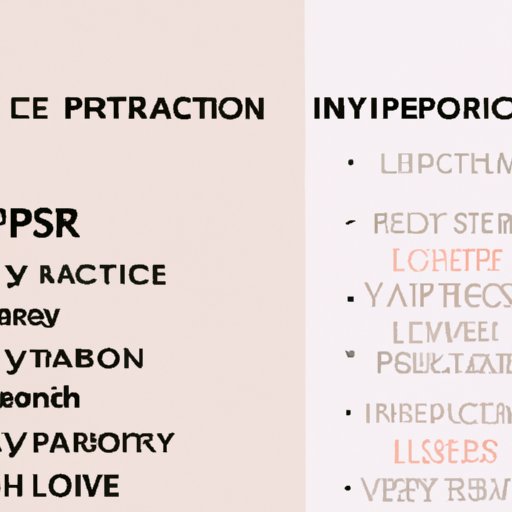
Introduction
Intense pulsed light (IPL) is a facial rejuvenation treatment that uses powerful flashes of light to improve the appearance of skin. It can help reduce wrinkles, sunspots, and other signs of aging. In this article, we’ll explore how does IPL work, from the basics to the technology behind it.
Exploring the Basics of IPL: How Does It Work?
Before we dive into the specifics of how IPL works, let’s take a look at what IPL is and how it works.
What is IPL?
IPL stands for intense pulsed light. It is a type of laser treatment used to treat various skin conditions such as wrinkles, sunspots, and acne scars. During an IPL treatment, a handheld device emits short bursts of light onto the skin. The light is absorbed by the targeted area, causing minor damage to the skin cells, which in turn stimulates collagen production and new skin cell growth.
How Does IPL Work?
IPL works by emitting pulses of light that penetrate the skin and target specific areas of concern. The light energy is absorbed by the skin and converted into heat energy. This heat energy causes minor damage to the skin cells, which triggers the body’s natural healing process and stimulates collagen production. Over time, this helps to improve the appearance of wrinkles, sunspots, and other signs of aging.
The Different Types of IPL Treatment
There are several different types of IPL treatments available. The most common types are photofacials, which are used to treat sunspots, wrinkles, and other signs of aging; laser hair removal, which is used to remove unwanted hair; and laser resurfacing, which is used to reduce the appearance of scars and stretch marks.
Understanding the Technology Behind IPL
Now that we’ve explored the basics of IPL, let’s take a closer look at the technology behind it.
The Science of IPL
IPL works by using light to target specific areas of the skin. The light is emitted in short pulses, which are absorbed by the targeted area. The absorption of the light energy causes minor damage to the skin cells, which in turn stimulates collagen production and new skin cell growth.
How IPL Generates Heat
IPL works by generating heat energy, which is then absorbed by the targeted area of skin. The heat energy causes minor damage to the skin cells, which in turn triggers the body’s natural healing process and stimulates collagen production. Over time, this helps to improve the appearance of wrinkles, sunspots, and other signs of aging.
The Different Wavelengths Used in IPL Treatments
IPL treatments use different wavelengths of light to target specific areas of the skin. These wavelengths range from 400 nanometers (nm) to 1,400 nm. Different wavelengths are used to target different problems, such as wrinkles, sunspots, and acne scars.
An In-Depth Guide to IPL: What You Need to Know
When considering an IPL treatment, it’s important to know what to expect. Here’s an in-depth guide to IPL and what you need to know before getting started.
Choosing the Right IPL Device
It’s important to choose an IPL device that is specifically designed for your skin type and condition. Different devices have different settings and capabilities, so it’s important to choose one that is best suited for your needs.
Preparing for an IPL Treatment
Before having an IPL treatment, it’s important to prepare your skin. This includes avoiding tanning, wearing sunscreen, and avoiding certain medications or supplements that may increase sensitivity to light. It’s also important to tell your doctor about any medical conditions you may have.
Aftercare and Maintenance
After an IPL treatment, it’s important to follow aftercare instructions to ensure optimal results. This includes avoiding direct sunlight, avoiding certain products or activities, and following a skincare routine. Following these tips will help to maintain the results of the treatment.
A Comprehensive Guide to How IPL Works
In addition to understanding the basics of IPL, it’s important to understand the benefits, side effects, and risks associated with the procedure.
The Benefits of IPL
IPL can be an effective way to improve the appearance of wrinkles, sunspots, and other signs of aging. It can also be used to treat acne and reduce the appearance of scars and stretch marks. Additionally, IPL can be used to treat certain skin conditions, such as rosacea.
Common Side Effects of IPL
Most peopletemporary redness
Risks Associated with IPL
IPL treatmentspermanent discoloration
Conclusion
IPL is a facial rejuvenation treatment that uses powerful flashes of light to improve the appearance of skin. It can help reduce wrinkles, sunspots, and other signs of aging. In this article, we’ve explored how does IPL work, from the basics to the technology behind it. We’ve also discussed the benefits, side effects, and risks associated with IPL treatments.
Overall, IPL is a safe and effective treatment for improving the appearance of skin. However, it’s important to talk to your doctor about the risks and make sure you’re prepared for the treatment. With the right preparation and care, IPL can help you achieve the results you want.
(Note: Is this article not meeting your expectations? Do you have knowledge or insights to share? Unlock new opportunities and expand your reach by joining our authors team. Click Registration to join us and share your expertise with our readers.)






































